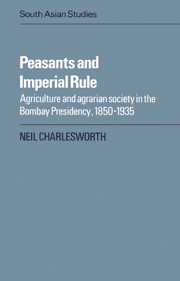Book contents
- Frontmatter
- Contents
- List of maps and tables
- Preface
- Note on technical terms and references
- Maps
- 1 Introduction: the peasant in India and Bombay Presidency
- 2 The village in 1850: land tenure, social structure and revenue policy
- 3 The village in 1850: land and agriculture
- 4 Indebtedness and the Deccan Riots of 1875
- 5 Continuity and change in the rural economy, 1850–1900
- 6 The Bombay peasantry, 1850–1900: social stability or social stratification?
- 7 The agricultural economy, 1900–1935: the critical watershed?
- 8 The impact of government policy, 1880–1935
- 9 The peasant and politics in the early twentieth century
- 10 Conclusions: the problem of differential commercialisation
- Glossary
- Bibliography
- Index
6 - The Bombay peasantry, 1850–1900: social stability or social stratification?
Published online by Cambridge University Press: 10 December 2009
- Frontmatter
- Contents
- List of maps and tables
- Preface
- Note on technical terms and references
- Maps
- 1 Introduction: the peasant in India and Bombay Presidency
- 2 The village in 1850: land tenure, social structure and revenue policy
- 3 The village in 1850: land and agriculture
- 4 Indebtedness and the Deccan Riots of 1875
- 5 Continuity and change in the rural economy, 1850–1900
- 6 The Bombay peasantry, 1850–1900: social stability or social stratification?
- 7 The agricultural economy, 1900–1935: the critical watershed?
- 8 The impact of government policy, 1880–1935
- 9 The peasant and politics in the early twentieth century
- 10 Conclusions: the problem of differential commercialisation
- Glossary
- Bibliography
- Index
Summary
The pattern of economic change we have described – marked, during the later nineteenth century, by a highly divergent process of commercialisation – permits, in turning to its social impact, the presentation of a familiar theme. During the 1970s it became almost established orthodoxy, so far as that ever exists in Indian history, to see the onset of a more extensive commercialisation within the peasant economy as creating significant social stratification. Access to the opportunities presented by commercialisation, it is often argued, depended on control of resources, such as bullock carts, irrigation facilities and, particularly, capital and credit, which were not widely held within village society. In turn, the cultivation of cash crops and their sale to wider markets allegedly gave the commercial producer enhanced wealth and power compared with the bulk of the villagers who remained, primarily, under the tutelage of subsistence concerns. In sum, the ‘rich peasant’ is frequently seen as the beneficiary of rural change in the late nineteenth century. Social stratification, of course, has long been a traditional theme of Indian agrarian history, antedating detailed economic analyses of rural markets and commerce, but its causes, in the historiography of the 1960s, were typically ascribed to government policy or socio-political processes. This emphasis has steadily disappeared in the more recent literature, leaving differential patterns of commercialisation strengthening stratification as the interpretation of both economic and social historian. This connection has been stressed not only within our interpretation of western India but also, prominently, by Washbrook and the Rays from parallel developments in Madras and Bengal.
- Type
- Chapter
- Information
- Peasants and Imperial RuleAgriculture and Agrarian Society in the Bombay Presidency 1850–1935, pp. 162 - 203Publisher: Cambridge University PressPrint publication year: 1985



